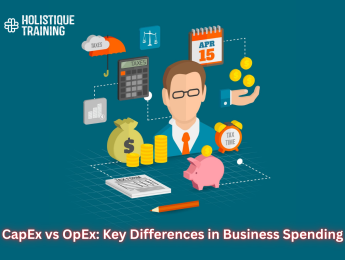- Table of Contents
- Introduction
- What is CapEx?
- How CapEx Works
- When to Classify an Expense as CapEx
- 1. Nature of the Expenditure
- 2. Useful Life of the Asset
- 3. Cost Thresholds
- 4. Regulatory and Accounting Standards
- 5. Intent of the Expenditure
- What is OpEx?
- How OpEx Works
- What is Considered OpEx?
- Common Categories of OpEx
- Salaries and Wages
- Rent and Utilities
- Office Supplies and Equipment
- Marketing and Advertising
- Maintenance and Repairs
- Professional Services
- Insurance
- Research and Development (R&D)
- Importance of Managing OpEx
- CapEx vs. OpEx: What is the Difference?
- 1. Nature of Expenses
- 2. Accounting Treatment
- 3. Impact on Cash Flow
- 4. Reporting and Financial Analysis
- 5. Benefits and Challenges
- 6. Strategic Considerations
- 7. Industry Variations
- Formulas
- CapEx and OpEx Examples
- CapEx Examples
- OpEx Examples
- Conclusion
Introduction
Navigating the financial landscape of a business requires a clear understanding of various terms and concepts that dictate how expenses are categorized and managed. Among these, the distinction between Capital Expenditures (CapEx) and Operating Expenditures (OpEx) stands out as crucial for effective financial planning and reporting. This blog post delves into the intricacies of CapEx and OpEx, exploring their definitions, classifications, differences, and real-world examples. By the end of this discussion, readers will gain a comprehensive understanding of how these expenditures impact a company's financial health and strategic decisions.
What is CapEx?
Capital Expenditures, commonly referred to as CapEx, represent the funds a company invests in acquiring, upgrading, or maintaining physical assets. These assets typically include property, buildings, machinery, and equipment that are essential for the company’s operations and long-term growth. CapEx is characterized by its long-term nature, as these investments are expected to provide benefits over multiple accounting periods, often several years.
How CapEx Works
When a business decides to invest in CapEx, it is essentially making a significant financial commitment aimed at enhancing its operational capacity or efficiency. The process usually involves several steps:
- Planning: Companies assess their needs for new equipment or facilities, considering factors such as current performance, future growth, and technological advancements.
- Approval: Proposed CapEx projects often require approval from upper management or the board of directors, given their substantial financial implications.
- Execution: Once approved, the company allocates funds and executes the project, which may involve purchasing new assets, constructing buildings, or upgrading existing facilities.
- Depreciation: Unlike OpEx, which is expensed immediately, CapEx is capitalized on the balance sheet and depreciated over time. This means that the cost of the asset is spread out over its useful life, impacting the company’s income statement gradually.
When to Classify an Expense as CapEx
Classifying an expense as a Capital Expenditure (CapEx) is essential for accurate financial reporting and strategic planning. Proper classification helps businesses understand their investment in long-term assets and the impact of these investments on future profitability. Here are the key criteria and considerations for determining when an expense should be classified as CapEx:
1. Nature of the Expenditure
The primary factor in classifying an expense as CapEx is its nature. CapEx typically involves expenditures that result in the acquisition, enhancement, or improvement of physical assets. This includes:
- Acquisition of New Assets: If a company purchases new machinery, vehicles, or buildings, these costs are classified as CapEx because they create new assets that will provide benefits over multiple years.
- Enhancements or Improvements: Expenses incurred to significantly enhance the value or extend the useful life of an existing asset qualify as CapEx. For example, if a company upgrades its production line with advanced technology that increases efficiency, this expenditure is considered CapEx.
2. Useful Life of the Asset
A crucial criterion for CapEx classification is the expected useful life of the asset. To qualify as CapEx, the asset must have a useful life extending beyond one year. This long-term perspective is essential because:
- Depreciation: CapEx is capitalized on the balance sheet and depreciated over the asset's useful life. If the asset's life is less than one year, it would not be appropriate to capitalize the expense, as it should be fully expensed in the current period.
- Strategic Investment: Classifying an expense as CapEx implies that the company is making a strategic investment intended to provide benefits over the long term, aligning with its growth and operational goals.
Examples of CapEx |
Purchase of machinery and equipment |
Construction or renovation of buildings |
Acquisition of land or property |
Upgrades to existing assets (e.g., software) |
Vehicles or fleet purchases |
3. Cost Thresholds
Many companies establish internal cost thresholds to differentiate between CapEx and Operating Expenditures (OpEx). These thresholds help streamline financial reporting and decision-making processes. Here’s how they work:
- Capitalization Policy: Organizations often set a minimum dollar amount for expenditures that can be capitalized. For instance, a company may decide that any expense over $5,000 will be classified as CapEx, while smaller expenses will be treated as OpEx. This policy helps avoid the administrative burden of tracking numerous small expenses as capital assets.
- Industry Standards: Different industries may have varying thresholds based on common practices. Companies should consider industry norms when establishing their capitalization policies to ensure consistency and comparability.
4. Regulatory and Accounting Standards
Accounting standards and regulations play a significant role in determining how expenses are classified. Businesses must adhere to generally accepted accounting principles (GAAP) or International Financial Reporting Standards (IFRS), which provide guidelines on CapEx classification. Key considerations include:
- Asset Recognition Criteria: Both GAAP and IFRS outline specific criteria for recognizing assets, including the probability of future economic benefits and the ability to measure the cost reliably. Expenses meeting these criteria can be classified as CapEx.
- Consistency: Companies should maintain consistency in their accounting practices. Once a policy is established for classifying expenses, it should be applied uniformly to ensure accurate financial reporting and compliance with regulatory requirements.
5. Intent of the Expenditure
The intent behind the expenditure is also a critical factor in classification. If the primary purpose of the spending is to acquire or enhance an asset for long-term use, it should be classified as CapEx. This can include:
- Strategic Growth Initiatives: Investments aimed at expanding production capacity, entering new markets, or enhancing operational efficiency typically fall under CapEx. For example, building a new factory to increase production capabilities is a strategic investment classified as CapEx.
- Research and Development (R&D): While R&D expenses are often treated as OpEx, certain R&D expenditures that lead to the development of new products or technologies with long-term benefits may qualify as CapEx if they meet the criteria for asset capitalization.
What is OpEx?
Operating Expenditures, or OpEx, refer to the ongoing costs for running a business on a day-to-day basis. These expenses are essential for the company’s operational functionality and include costs such as rent, utilities, salaries, and office supplies. Unlike CapEx, OpEx is typically short-term in nature and is fully expensed in the accounting period in which they are incurred.
How OpEx Works
OpEx plays a vital role in a company’s financial operations. The process of managing OpEx involves:
- Budgeting: Companies create budgets that outline expected operating costs, ensuring they can maintain day-to-day functions without overspending.
- Monitoring: Regular tracking of OpEx is essential to identify any variances from the budget, allowing management to make necessary adjustments.
- Reporting: OpEx is reported on the income statement, directly impacting net income for the period. Unlike CapEx, there is no need for depreciation, making OpEx easier to account for.
What is Considered OpEx?
Operating Expenditures (OpEx) are the ongoing costs that a business incurs to maintain its day-to-day operations. These expenses are essential for keeping the business running smoothly and generating revenue. Unlike Capital Expenditures (CapEx), which are long-term investments in physical assets, OpEx reflects the costs associated with the regular functioning of the company. Understanding what constitutes OpEx is crucial for effective financial management and budgeting.
Common Categories of OpEx
OpEx encompasses a wide range of expenses that can be broadly categorized into several key areas:
Salaries and Wages
- Employee Compensation: This includes the salaries, wages, bonuses, and commissions paid to employees across all levels of the organization. Employee compensation is typically the largest component of OpEx for many businesses.
- Benefits and Payroll Taxes: In addition to direct salary payments, OpEx also includes costs related to employee benefits such as health insurance, retirement contributions, and payroll taxes. These costs contribute significantly to the overall expense of maintaining a workforce.
Rent and Utilities
- Leasing Costs: Businesses often incur rental expenses for office space, warehouses, or retail locations. These costs are recurring and essential for operational functionality.
- Utility Expenses: Regular payments for utilities such as electricity, water, heating, and internet services fall under OpEx. These expenses are necessary for maintaining a conducive working environment and supporting business operations.
Examples of OpEx |
Salaries and wages for employees |
Rent and lease payments |
Utility bills (electricity, water, etc.) |
Office supplies and materials |
Marketing and advertising expenses |
Office Supplies and Equipment
- Consumables: Everyday items such as paper, pens, printer ink, and other office supplies are considered OpEx. These items are typically low-cost and used up quickly, making them essential for daily operations.
- Minor Equipment Purchases: While large equipment purchases may be classified as CapEx, smaller items like computers, printers, and furniture that do not meet the threshold for capitalization are categorized as OpEx.
Marketing and Advertising
- Promotional Costs: Expenses related to marketing campaigns, advertising, public relations, and promotional events are included in OpEx. These costs are vital for attracting customers and driving sales.
- Digital Marketing: In the digital age, expenditures on online advertising, social media promotions, and search engine optimization (SEO) services are also classified as OpEx. These expenses are crucial for maintaining a competitive edge in the market.
Maintenance and Repairs
- Routine Maintenance: Costs incurred for the regular upkeep of equipment, machinery, and facilities are classified as OpEx. This includes expenses such as servicing machinery, cleaning, and minor repairs that do not significantly enhance asset value.
- Repairs: Immediate repairs necessary to fix equipment breakdowns or facility issues are also considered OpEx. These expenditures ensure that operations continue without significant interruptions.
Professional Services
- Consulting and Legal Fees: Businesses often engage external consultants, legal advisors, and accountants to provide expertise and support. The fees paid for these professional services are classified as OpEx.
- Outsourced Services: Companies may outsource functions such as IT support, human resources, and customer service. The costs associated with these outsourced services fall under OpEx and are essential for maintaining operational efficiency.
Insurance
Business Insurance: Premiums paid for various types of insurance, including liability, property, and workers' compensation insurance, are considered OpEx. Insurance is crucial for mitigating risks associated with business operations.
Research and Development (R&D)
Innovation Costs: While some R&D expenses can be capitalized under specific conditions, many companies treat ongoing research and development costs as OpEx. These expenditures are vital for fostering innovation and maintaining competitiveness in the market.
Importance of Managing OpEx
Effectively managing OpEx is critical for several reasons:
- Cash Flow Management: Since OpEx represents ongoing expenses, businesses must ensure they maintain sufficient cash flow to cover these costs. Poor management of OpEx can lead to cash flow shortages, impacting the ability to meet financial obligations.
- Profitability Analysis: Monitoring OpEx helps businesses assess their profitability and operational efficiency. High OpEx relative to revenue may signal inefficiencies that need to be addressed to improve margins.
- Budgeting and Forecasting: Understanding the components of OpEx allows companies to create accurate budgets and forecasts. This helps in planning for future expenses and making informed decisions about resource allocation.
- Cost Control: By identifying and analyzing OpEx, businesses can implement cost control measures to reduce unnecessary expenses. This can enhance overall profitability and provide additional resources for strategic investments.
Operating Expenditures are a fundamental aspect of running a business, encompassing a wide range of necessary costs that keep operations running smoothly. From employee salaries to marketing expenses, each component of OpEx plays a crucial role in ensuring that a company can function effectively and achieve its financial goals. By understanding what constitutes OpEx and managing these expenses wisely, businesses can enhance their operational efficiency, improve cash flow, and ultimately drive profitability.
CapEx vs. OpEx: What is the Difference?
Understanding the differences between Capital Expenditures (CapEx) and Operating Expenditures (OpEx) is crucial for effective financial management and strategic decision-making within a business. While both types of expenditures are essential for a company's operations, they serve different purposes and have distinct implications for financial reporting, cash flow, and overall business strategy. Below, we delve deeper into the key differences, exploring various dimensions such as nature, accounting treatment, impact on cash flow, reporting, benefits, challenges, and their respective roles in financial analysis.
1. Nature of Expenses
- CapEx: Capital Expenditures are long-term investments made to acquire, upgrade, or maintain physical assets that will benefit the company over several years. These expenses are typically substantial and involve significant capital outlay. Examples include purchasing machinery, constructing buildings, or acquiring land.
- OpEx: Operating Expenditures are ongoing costs incurred in the daily functioning of a business. These expenses are necessary to maintain operational efficiency and support revenue generation but do not result in the acquisition of long-term assets. Examples include rent, utilities, and salaries.
2. Accounting Treatment
- CapEx: When a company incurs a capital expenditure, it capitalizes the cost on its balance sheet. This means the expenditure is recorded as an asset rather than an immediate expense. Over time, the asset is depreciated (or amortized, in the case of intangible assets), spreading the cost over its useful life. This depreciation affects the income statement gradually, reducing taxable income over several years.
- OpEx: Operating expenditures are recorded as expenses on the income statement in the period they are incurred. This means that they are fully deducted from revenue in the same accounting period, directly impacting net income. There is no need for depreciation, making OpEx simpler to account for and report.
3. Impact on Cash Flow
- CapEx: Capital expenditures often involve large cash outflows at the time of purchase, which can significantly impact a company's cash flow in the short term. However, these expenditures are expected to generate long-term benefits, potentially leading to increased revenue and profitability over time.
- OpEx: Operating expenditures typically involve smaller, regular cash outflows that occur consistently throughout the year. While they are essential for maintaining day-to-day operations, they do not have the same long-term impact on cash flow as CapEx. Companies must manage OpEx carefully to avoid cash flow issues, especially if revenues fluctuate.
Aspect | CapEx | OpEx |
Definition | Long-term investments in physical assets | Ongoing costs for daily business operations |
Purpose | To acquire or improve assets for future use | To maintain current operations and generate revenue |
Accounting Treatment | Capitalized on the balance sheet and depreciated | Expensed on the income statement in the period incurred |
Impact on Cash Flow | Significant upfront cash outflow, long-term benefits | Regular cash outflows that affect short-term cash flow |
Examples | Machinery purchases, building renovations | Salaries, rent, utilities, office supplies |
4. Reporting and Financial Analysis
- CapEx: CapEx is reported as assets on the balance sheet, which contributes to the total asset value of the company. Financial analysts often look at capital expenditures to assess a company’s growth potential and investment strategy. Key metrics such as Return on Investment (ROI) can be calculated to evaluate the effectiveness of CapEx decisions. Analysts may also consider the ratio of CapEx to depreciation to understand how much a company is investing in maintaining or expanding its asset base.
- OpEx: Operating expenditures are reported as expenses on the income statement, affecting net income directly. Analysts often examine OpEx in relation to revenue to calculate operating margins, which provide insights into a company’s operational efficiency. High OpEx relative to revenue may indicate inefficiencies or the need for cost-cutting measures.
5. Benefits and Challenges
CapEx Benefits:
- Long-Term Growth: CapEx investments can lead to increased production capacity, improved efficiency, and enhanced competitive advantage.
- Asset Appreciation: Physical assets may appreciate in value over time, contributing to the overall worth of the company.
- Tax Benefits: Depreciation allows companies to spread the cost of assets over time, providing tax benefits that can improve cash flow.
CapEx Challenges:
- High Initial Costs: CapEx often requires significant upfront investment, which can strain cash reserves and limit financial flexibility.
- Long Decision-Making Processes: The approval process for CapEx can be lengthy, requiring detailed justifications and risk assessments.
- Risk of Obsolescence: Rapid technological advancements can render capital assets obsolete, leading to potential losses if the investment does not yield expected returns.
OpEx Benefits:
- Flexibility: OpEx allows for more flexible budgeting and financial planning since these expenses can be adjusted based on current operational needs.
- Immediate Tax Deductions: OpEx expenses are fully deductible in the year they are incurred, providing immediate tax relief.
- Easier Management: OpEx is typically easier to monitor and manage, allowing businesses to respond quickly to changes in operational needs.
OpEx Challenges:
- Continuous Monitoring Required: Businesses must regularly track and manage OpEx to avoid overspending, which can impact profitability.
- Potential for Escalating Costs: If not carefully managed, OpEx can escalate over time, particularly in areas like utilities and salaries.
- Less Control Over Long-Term Investments: Focusing too heavily on OpEx may lead to underinvestment in essential long-term assets, potentially hindering future growth.
6. Strategic Considerations
The choice between CapEx and OpEx can also reflect a company's strategic priorities and business model. For example:
- Growth-Oriented Companies: Firms focused on aggressive growth may lean toward CapEx to invest in new technologies and infrastructure that will drive future revenue. These companies often prioritize long-term asset acquisition to position themselves competitively in the market.
- Cost-Conscious Companies: Businesses that prioritize cost management and efficiency may favor OpEx, opting for flexible operational expenditures that can be adjusted based on current economic conditions. This approach allows them to maintain agility in a rapidly changing market.
7. Industry Variations
The distinction between CapEx and OpEx can vary significantly across different industries. For instance:
- Manufacturing: A manufacturing company might have substantial CapEx for machinery and equipment, while also incurring significant OpEx for labor and raw materials. The balance between these expenditures is critical for optimizing production efficiency.
- Technology: In the technology sector, companies may invest heavily in CapEx for data centers and infrastructure, while also incurring OpEx related to software subscriptions and cloud services. The trend toward cloud computing has blurred the lines, as many companies now classify cloud services as OpEx rather than CapEx.
- Retail: Retail businesses often have high OpEx due to ongoing costs like rent and staffing, but they also invest in CapEx for store renovations and technology upgrades to enhance customer experience.
Formulas
While not typically associated with specific formulas, understanding the financial implications of CapEx and OpEx can be enhanced through basic calculations:
- Return on Investment (ROI) for CapEx:
ROI=(Net Profit - Cost of Investment)Cost of Investment 100
- Operating Margin for OpEx:
Operating Margin=Operating IncomeRevenue 100
In summary, the differences between CapEx and OpEx extend beyond simple definitions; they encompass various aspects of financial management, reporting, and strategic planning. Understanding these distinctions enables businesses to make informed decisions regarding their investments and operational expenditures. By balancing CapEx and OpEx effectively, companies can optimize their financial performance, enhance operational efficiency, and position themselves for long-term success.
CapEx and OpEx Examples
CapEx Examples
- Purchasing Machinery: A manufacturing company invests $500,000 in new machinery to increase production capacity. This expenditure is classified as CapEx because it creates a long-term asset.
- Building Renovation: A retail store spends $200,000 to renovate its premises, enhancing customer experience and increasing foot traffic. This is also CapEx due to the improvement of an existing asset.
OpEx Examples
- Employee Salaries: A company pays $100,000 in salaries for its staff during a fiscal quarter. This is classified as OpEx as it is a recurring expense necessary for operations.
- Utility Bills: Monthly utility expenses of $5,000 for electricity and water are considered OpEx since they are ongoing costs required for daily operations.
Conclusion
Grasping the distinctions between Capital Expenditures (CapEx) and Operating Expenditures (OpEx) is fundamental for effective financial management and strategic planning in any business. Each type of expenditure plays a vital role in shaping the financial landscape of an organization, influencing cash flow, profitability, and long-term growth potential. Understanding these differences is not just an academic exercise; it is essential for making sound financial decisions that drive success.
By mastering when to classify expenses as CapEx or OpEx, businesses can optimize their financial strategies and allocate resources more effectively. This knowledge enables organizations to assess their investments critically, ensuring that every dollar spent contributes to their operational goals and overall mission. In today’s fast-paced and dynamic market environment, where adaptability is key, a solid grasp of these concepts empowers companies to navigate the complexities of financial management with confidence and clarity.
Our course, Business Financial Planning and Control, is designed to equip you with the skills and knowledge necessary to excel in understanding and managing both CapEx and OpEx. Through comprehensive lessons and practical applications, you will learn how to analyze financial data, make informed decisions, and implement effective budgeting strategies that align with your business objectives.
This comprehensive exploration of CapEx and OpEx not only clarifies their definitions and classifications but also highlights their importance in the broader context of business operations. As organizations strive for efficiency and growth, recognizing the nuances of these expenditures will remain a critical component of successful financial planning. By enrolling in our course, you will gain valuable insights and practical tools that will enhance your financial acumen, ultimately leading to better decision-making and improved organizational performance.
Join us in Business Financial Planning and Control to ensure that you are well-prepared to tackle the financial challenges of today’s business landscape. Equip yourself with the knowledge that will empower you to drive your organization towards sustained growth and profitability.

























